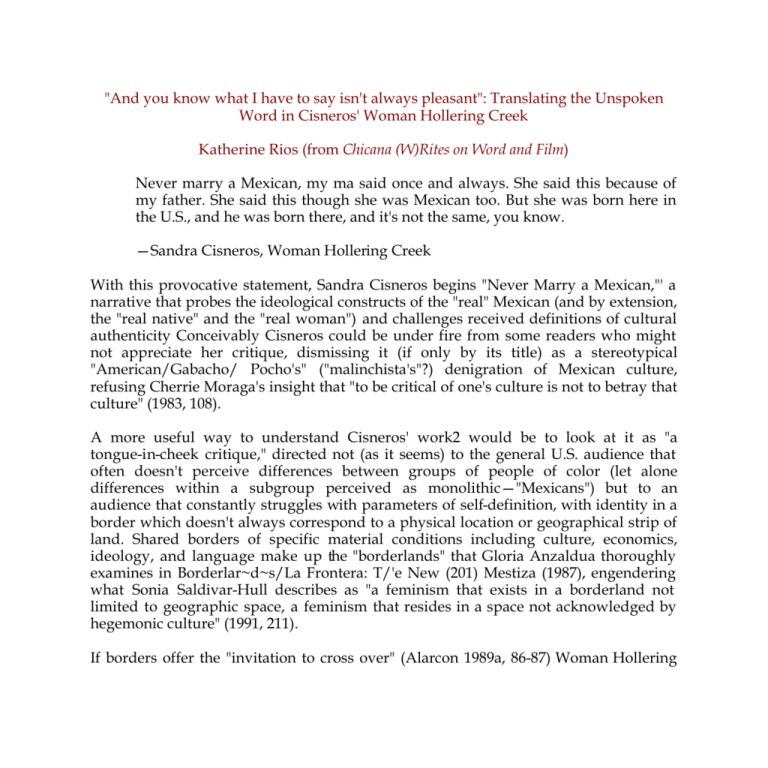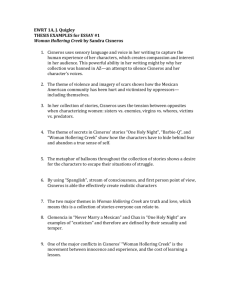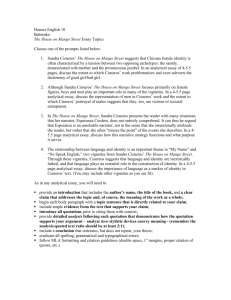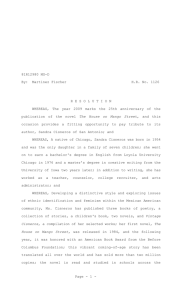Translating the Unspoken Word in Cisneros' Woman Hollering Cr
advertisement

"And you know what I have to say isn't always pleasant": Translating the Unspoken Word in Cisneros' Woman Hollering Creek Katherine Rios (from Chicana (W)Rites on Word and Film) Never marry a Mexican, my ma said once and always. She said this because of my father. She said this though she was Mexican too. But she was born here in the U.S., and he was born there, and it's not the same, you know. —Sandra Cisneros, Woman Hollering Creek With this provocative statement, Sandra Cisneros begins "Never Marry a Mexican,"' a narrative that probes the ideological constructs of the "real" Mexican (and by extension, the "real native" and the "real woman") and challenges received definitions of cultural authenticity Conceivably Cisneros could be under fire from some readers who might not appreciate her critique, dismissing it (if only by its title) as a stereotypical "American/Gabacho/ Pocho's" ("malinchista's"?) denigration of Mexican culture, refusing Cherrie Moraga's insight that "to be critical of one's culture is not to betray that culture" (1983, 108). A more useful way to understand Cisneros' work2 would be to look at it as "a tongue-in-cheek critique," directed not (as it seems) to the general U.S. audience that often doesn't perceive differences between groups of people of color (let alone differences within a subgroup perceived as monolithic—"Mexicans") but to an audience that constantly struggles with parameters of self-definition, with identity in a border which doesn't always correspond to a physical location or geographical strip of land. Shared borders of specific material conditions including culture, economics, ideology, and language make up the "borderlands" that Gloria Anzaldua thoroughly examines in Borderlar~d~s/La Frontera: T/'e New (201) Mestiza (1987), engendering what Sonia Saldivar-Hull describes as "a feminism that exists in a borderland not limited to geographic space, a feminism that resides in a space not acknowledged by hegemonic culture" (1991, 211). If borders offer the "invitation to cross over" (Alarcon 1989a, 86-87) Woman Hollering Creek offers a collection of stories about "crossing over" in all its manifestations: across geographical borders and borders of culture, class and color; through language and writing; and even across theoretical borders, braving the "crossfire" between hegemonic theoretical discourses. Cisneros explores how these "crossings" or traversals impact identity, authenticity, and the construction of subjectivity in a variety of complex and highly competing ways. Hers is a self-reflexive, self- critical analysis of the utterly transgressive nature of "crossing over" even as it is a distressingly routine way of life for border people—not just people located in or on a physical, geographical border, but as Anzaldua puts it, those who are the cultural outcasts (38). Such crossings require risky negotiations. As Alvina Quintana notes, "The Chicana writer is. . . engaged in mediating and negotiating between two cultural systems" so that "Chicane literature functions as a bold cultural intervention, which ironically enough resembles what we have come to respect as interpretive or experimental ethnography" (1991, 74-75). While Quintana's reference applies to the author's use of her characters as ethnographers, or the Chicana critic who occupies an intermediary role in discursive practices,3 I extend the analogy to examine how Cisneros' work discloses the self-consciousness of the Chicana's betrayal and transgression as she attempts to interpret, translate, and cross cultures. In this context, the comment "Who wouldtve guessed, after all this time, it is me who will remember when everything else is forgotten, you who took with you to your stone bed something irretrievable, without a name" (Cisneros, "Tepayac," 23) gains a different valence; the "me" is the transgressive one who crossed over, who supposedly betrayed her people by interpreting myths and icons and telling stories. As the ethnographer or translator faced with analytical discourses which lend authority to the "enigma" of alterity: the Other, the Mexican, the Native, the Woman, and the exemplary case of the native woman who traverses all those subject positions (202) or identities, she can only insist that there is no essential, authentic identity with secrets to reveal. There is no "real" Mexican, no "real" native, no "real" woman; no pure identity uncontaminated by crossing over to el otro lado and fraternizing or collaborating with the "enemy." There are no secrets—but Cisneros tells them. The deliberate contradiction of this statement reveals the dislocated, non-linear, and ambiguous stance that Chicana critics must take as a strategy of self- definition that neither accepts nor denies, but unsettles, displaces and restates the question, like Gayatri Spivak's question: "What does this mean?" (1988, 297). In "Never Marry a Mexican," the Mexican narrator Clemencia recounts two major betrayals in her life: her mother's adultery and subsequent marriage to a white man, by which Clemencia is effectively disinherited; and her rejection by Drew, her lover and art teacher, an older white man who leaves her after his white wife bears their child. Clemencia also reveals transgressions of her own, including her many liaisons with married men and more importantly, the secret affair she maintains with Drew's now- teenage son. For the Chicana reader, the events and characters of "Never Marry a Mexican" can't help but evoke comparison with the cultural-historical Malinche myth, Malinchei being the "real—life" native woman who assisted Cortes by translating for him, enabling his victory over the Aztecs and thereby mobilizing Spain's colonization of Mexico. Certainly there are enough textual references in "Never Marry. . . " to merit a reading of the story as a reconstruction and revision of the Malinche story, most obviously as Clemencia, the Mexicans narrator and Drew, her Anglo lover, playfully pose as the historical characters: Drew, remember when you used to caH me your MalinaHi? It was a joke, a private game between us, because you looked like a Cortez. . . My skin dark against yours. . . My MalinaHi, Malinche, my courtesan, you said. . . (74) The Malinche myth is so pervasive that one critic, Emma Perez, claims the "metaphor cuts to the core of every Chicana," and limits her explanation to a footnote: "I will not reiterate this history, I assume most already know it...ask any Chicana about Paz's chingada" (1991, 167, 183). Malinche has become an icon of Chicana identity (or misidentification), sometimes even referred to as (203) a "prototype" (Candelaria 1980). In fact, when I mentioned I was reading this story as a revision of the Malinche myth, a Chicana friend countered, "Is there any other way to read the story?"6 Of course there are many ways to read the story, including ways that might ignore its cultural specificity and its historical implications in self-interested projects presenting other theoretical perspectives—non-culturally specific feminist readings, for example. On the other hand, a feminist-materialist reading could be equally prohibitive, limiting the possibility of reading silence as I read it in Cisneros' work. A cultural-historical reading is crucial because Cisneros recuperates the Malinche/Guadalupe/Llorona triad—the three icons that supposedly structure the psychic and material basis of Chicana identity—throughout her stories. Because, according to Anzaldua, "ambiguity surrounds the symbols of these three 'Mothers' and 'mediators' " (30-31), an interpretation of "Never Marry a Mexican" demands an intertextual reading of other stories in her collection which would interplay with it, or even contest it; scraping up against it like the festering "scab" where "the Third World grates against the first and bleeds" (Anzaldua, 3). Throughout her stories, Cisneros incorporates narrative reversals and scrutinizes ideological slippages in the construction of these "mothers," challenging and demystifying authenticity through revisions of icons, representations, and myths. She launches a critique that is as multidimensional as the positions its author—and other Chicanas—daily occupy. Using her tongue-in-cheek approach in another story, "Bien Pretty," Cisneros perceives "authenticity" as determined by whether one speaks Spanish and when ("When Flavio accidentally hammered his thumb, he never yelled 'Ouch!' he said 'Ay!' The true test of a native Spanish speaker" [153]),7 or dresses in ethnic clothing (like a "native"). Other signals of cultural authenticity hinge on whether one hangs Frida's paintings or displays Mexican pottery. Even the manner in which one walks (like Ixtacihuatl, the Indian princess turned goddess) indicates an authenticity modeled on the "royal" forebears rather than their slaves or the native workers who fashion the "ethnic" pottery, metal-work and weavings that are accumulated as signs of cultural identification (139-140). Lupe's (the protagonist's) inventory of cultural artifacts (which (204) are limited not only to the "ethnic" but also to "calidad,'—quality —a metaphor for "authenticity"?) in her borrowed house is a sardonic critique of the appropriation of culture through exotica. But it is also a devastating critique of the position of the Third World subject in the U.S., a subject whose fetishization of the "native" or ethnic to recuperate identity marks her inscription and indoctrination in a capitalist society that makes her complicit in the ideology of capitalist consumerism. Cisneros explores how "culture" is constructed as a commodity attainable by the accumulation of "signs" of authenticity, but the problem of authenticity demands more than a cursory class analysis. Translating the Knot of Race, Class, and Gender When (if) hegemonic theorists engage the oft-stated nexus of race, class, and gender, the categories are generally approached in isolation and effectively treated as static. For example, race is examined in relation to gender, gender in relation to class, and so on. Perhaps we need a three-dimensional model to approach the interrelationships of these categories in a way that isn't limited to foregrounding (and thereby prioritizing) any one category. "Real" material, historical conditions reveal the integral interplay and movement of these categories beyond boundaries and into dizzying configurations, as we see when Clemencia attempts to explain her mother's advice against marrying a Mexican:6 I guess she did it to spare me and Ximena the pain she went through . . . Having had to put up with all the grief a Mexican family can put on a girl because she was from el otro lado, the other side, and my father had married down by marrying her. If he had married a white woman from el otro l~do, that would've been different. That would've been marrying up, even if the white girl was poor. But what could be more ridiculous than a Mexican girl who couldn't even speak Spanish, who didn't know enough to set a separate plate for each course at dinner, nor how to fold cloth napkins, nor how to set the silverware. (Cisneros, "Never Marry a Mexican," 69) How does one begin to unravel a passage like this, so simply phrased and yet so laden with the complexities and shifts of multipositionality? Perhaps a way to begin is to look at how one writes (205)such positionality. Using reversals as a strategy of unsettling discourses, Cisneros' analysis pivots between nationality, gender roles, tradition, class, status, race, and language. For example, defining the U.S. as "el otro lado" rules the U.S. the "Other," designating another Subject. In this instance—instant—Cisneros re-locates the underclass in the U.S., upsetting the prevailing description of Mexico as Third World. She acknowledges Mexican class divisions and refuses the ideology of a monolithic Mexican identity, thereby refusing to romanticize the Mexican as the "indigenous, native" subject of the Third World. At the same time, her move doesn't rule out ethnocentrism on the part of Mexicans; that is, some Mexican nationals' disdain for the Mexican American in the U.S. as unauthentic and contaminated more by their association with "gringos" than by capitalism and class divisions. She acknowledges class hierarchies not strictly as a function of economics, but also of race or color consciousness. Entangled in this problematic is the privileging of the white woman over the brown native or indigenous woman and the contradiction inherent in the ambivalent desire for the status gained by marrying a white woman. Finally, she notes impositions of authenticity per language, foregrounding the question of what Anzaldua calls "language inadequacy" and "linguistic terrorism" (58) in the example of Clemencia's mother, who most likely speaks an imperfect Spanish rather than no Spanish at all.9 Cisneros' reversals of language involve code-switching, often leaving the Spanish untranslated. Subject-position determines which language is italicized as "Other," emphasizing free play and multipositionality In this way, Cisneros' use of code-switching is not just an indication of "bilinguality" but of multiple positionality. The passage, a scathing critique of cultural discourses of authenticity and their attendant demands, expectations, and exclusions thus draws attention to what is already sorely obvious to many; that is, the problem of location. Locating the critique and the shifts in positionality is next to impossible even momentarily, because the object of critique is never static. As Cisneros deconstructs this ideology of cultural identity (whose binary poles are not individuaHy pure, nor inviolable) as a kind of hegemony in the face of a resisting hybridity which is no longer only the hybridity of white/Spanish and indigenous/Mexican, but "American" in (206) combination with those identities, she attacks the question of identity itself. In her recognition of the materiality of subject positions, Cisneros refuses to see subjectivity merely as an abstraction or a privilege of intellectuals. With these complications in mind, it may come as a surprise that Cisneros' work should be so intensely pleasurable to read. It is precisely because of the cultural prohibitions delineated through the Malinche myth that the subversions of "Never Marry a Mexican" satisfy a desire for transgression and the expression of repressed rage. At a recent Chicano art exhibit, Cherrie Moraga commented: "what was missing was the rage and vengeance of women,"'? recalling Anzaldua's observation: "I have internalized rage and contempt, one part of the self using defense strategies against another part of the self (the object of contempt)" (45). The desire for a self-affirming model or narrative, as well as evidence of women's resistance and power, is sometimes expressed in the form of aggression or violence: I wanted you bare-breasted, snakes in your hands. I wanted you leaping and somersaulting the backs of bulls. I wanted you swaHowing raw hearts and rattling volcanic ash. I wasn't going to be my mother or my grandma. AH that self-sacrifice, aH that silent suffering. HeH no. Not here. Not me. (Cisneros, "Little Miracles, Kept Promises," 127) Cisneros, while recognizing the futility and misdirection of that violence doesn't repress it, but acknowledges and writes it." Clemencia is silent and impassive, like Guadalupe. Yet that silence is not inspired by "self-sacrifice"—far from it. She is, in fact, "swallowing raw hearts" and "bare-breasted," invoking both the native as the Mexica/Aztec and the classic image of the Amazon in a kind of revision of ritualistic sacrifice that actuaHy rejects the "native." Many revisionists interpret Malinche's vengeance as rage directed against the mother who sold her into slavery, her captors, and finally, if only metaphorically, her son by Cortes, the first Mexican and the figurative ancestor of aH Mexicans. In a sense, Cisneros rewrites the rage and translates the vengeance. The vengeance in Cisneros' version o f the myth is rewritten in Clemencia and directed against Drew (the figurative Cortes) and his 9207) white wife, through Clemencia's relationship with their son. Clemencia's unapologetic confession reveals her desire for Drew, a white man, and her indifference to brown men; her vengeful, strategic sexuality as demonstrated through her seductions of married men and her almost-incestuous manipulation of Drew's teenage son; and a spite exploding into rage. She demonstrates a dissociation from and disdain for other women (including other women of color), a rejection of a working class identity ("I'm amphibious. . . I'm a person who doesn't belong to any class" [71]) and her ready "prostitution" as a translator of travel brochures and an unwilling teacher. Finally, she rejects any possible semblance of "family" or maternity (she "can't stand kids" [71], and figuratively throws "the baby"—Megan's toy—into the creek, in a foreshadowing of her relationship with Megan's son); she even rejects her own mother ("Like I never even had one" [73]). This inversion of Paz's passive Malinche ("a heap of bones, blood and dust," the raped one, La Chingada [Paz 1961, 85]) to an aggressive one (like that Perez describes as a "maleness...constructed to be competitive, maniacal, and violent" [164-165]) is more like Paz's conception of the Chingon, the agent of that which is "cruel: it stings, wounds, gashes, stains. And it provokes a bitter, resentful satisfaction" (77). Paz's Chingon reverberates in Clemencia's confession: "It's given me a bit of crazy joy to be able to kill those women like that . . . To know I've had their husbands when they were anchored in blue hospital rooms, their guts yanked inside out. . . " (77) and recalls Moraga's musing: "what, indeed, must my body look like if I were both the Chingada and the Chingon?" (1983, 120-121). Can we read Clemencia's perverse delight in her seductions of Drew's son and other women's husbands while the women themselves ar' giving birth or still feeling their "ass stitches" (77) as a kinci ol psychic rape? If so, whose? Her relationship with Drew's son is, as Moraga says: "sex turned manipulation, control—which ravages the psyche rather than satisfy the yearning body and heart" (Moraga 1983, 137). Obsessed with plans for revenge, and knowing that Drew admires her eyes, Clemencia thinks: "after you left, I wanted to scoop them out with a spoon, place them on a plate . . .food for the blackbirds" (75). In the context of her "incestuous" relationship with her pseudo-son, this fantasy might be read as an Oedipal reversal whereby a "knowing" Jocasta blinds herself. But it is not guilt that inspires Clemencia, but rather, spite: "like cutting off one's nose to spite one's face"—a vengeance that is ultimately self-destructive, that is "eating away" at her, consuming her. If, as Tey Diana Rebolledo says, "Women are so silenced that they are only left to speak with 'their eyes,' "~2 the implications of self-silencing are further emphasized by the violence of the artist's loss of her eyes. Clemencia's appropriation of violence as agency is thus not a solution, but self-destructive. Instead of an avenue to self-affirmation, it is merely an appropriation of a patriarchal power which feminists continuously attempt to render impotent. Yet, like the unfinished business of "difference," rage has yet to be spoken, written, and heard. But Cisneros also moves beyond the pain and rage, that is, "pain or rage" as the only options or possibilities of interpretation. Like Anzaldua, Cisneros "write[s] the myths she want[s] to become."'3 In the story "Woman Hollering Creek," for example, the La Llorona myth is rewritten when the cry is reinterpreted as a gleeful "hoot" or a "holler like Tarzan" (56).'4 And in "Little Miracles, Promises Kept" Rosario reinterprets Guadalupe's "silent suffering" as "power" and "strength" (127- 128). Moving beyond the critique of the "native," Cisneros plunges into another trajectory, forging an attack on stereotypes of "woman" and the authenticity of the "real woman": [I]n my dreams I'm slapping the heroine to her senses, because I want them to be women who make things happen, not women who things happen to. Not loves that are tonnentosos. Not men powerful and passionate versus women either volatile or evil, or sweet and resigned. But women. Real women. The ones I've loved aH my life. If you don like it largate, honey. Those women. The ones I've known everywher except on TV, in books and magazines. Las girlfriends. Las con2adre~ Our mamas and tu~s. Passionate and powerful, tender and volatile, brave. And, above aH, fierce. ("Bien Pretty," 161) Lupe (like Cisneros?) watches for "real [live] women" as opposed to the representations of the magazine heroines or women in the telenovelas. The "real woman" is located somewhere in the border, boundary, in-between but yet not Anzaldua's essentialized woman, the "new mestiza." Rather than pushing the limits of "newer gender identities" (Alarcon 1989, 82), Cisneros seems to be questioning the "stalled" conditions of raced-ethnic gender (209) identities that have been routinely excluded from hegemonic discourses or obscured under the guise of dominant feminist identity politics: Crossings over by "choice" or by force become sporadic individual arrangements that do not necessarily change the status of Indian women or women of color. . . The realization that the "invitation" to cross over, when it is extended, does not ameliorate the lot of women of color in general has led, in the eighties, to a feminist literature by Chicanas and women of color which demonstrates that, despite some shared perspectives, boundaries exist and continue to exist, thus accounting for differential experiences that cannot be contained under the sign of a universal woman or women. (Alarchn 1989a, 86-87) Ironically, Clemencia doesn't "know" that she is a "native" until Drew rejects her. She ignores the reasons he offers (age difference and "responsibilities") and focuses on the real reason as she recalls their conversation: Besides, he could never marry me. You didn't think.... ? Never mar~y a Mexican. Never marry a Mexicar'... No, of course not. I see. I see. (Cisneros, "Never Marry," 80) Clemencia's ideology—"never marry a Mexican"—turns back on her, unsettling and disrupting her definition of self and her self- referentiality when she realizes that to Drew, she is a Mexican. In this way Clemencia may be seen as positioned like "the Chicana intellectual," who, Alarcon notes, "is now and has always been a Third World intellectual. . tit was being inside the U.S. [el otro lado] which has given her the wrong impression" (Alarcon 1991, 6, emphasis mine). Clemencia's language inadequacy: "But that's— how do you say it?—water under the damn? I can't ever get the sayings right even though I was born in this country"'5 points to her misinterpretations of positionality When Drew rejects Clemencia, cultural readings of denigration and scorn for The Cross-Over (the Ver~dida or "Sell-out") are proved correct. It seems the ultimate betrayal is not the loss of the lover, but the proof of a misalliance,'6 Clemencia's mistake, her mix-positioning, her misinterpretation of "power" or "privilege." The possibility of "crossing" by repositioning (or rejecting) one's class or cultural identity is exploded and at the same time, brings the power differential back to race and gender.'7(210) This devastating miscalculation is also at the root of the Chicana critic's anxiety in searching for a theory that "fits." She must be wary of a theory's seductive qualities, for fear that it ultimately might not "work," that it won't affect material practices or conditions. The Chicana critic must also be conscious of her limited "use-value" in theoretical circles that call for the voice of the woman of color. In Malinche's case, Alarcon notes that "once her usefulness is over she is silenced and disappears from the record" (1989, 86). Perhaps we can understand this as a warning to the Chicana critic (read tra1'slator) or the woman of color who speaks as a critic. Spivak's insistent question, "Can the subaltern (as woman) speak?" is posed as a way of getting at the intricacies of economy, power, and the discourses that encode us (1988, 296). But because there is no "unmediated" space from which the woman of color can speak, speech demands an unwilling participation in both equally controlling, dominant ideological discourses. The critic finds she must engage both binaries (albeit unwillingly, as there is no recourse), if only to deny them (307). An example of this problematic may be read in the mythical Malinche, always already the aggressive colluder or the passive victim, affording no in-between "border" identity Because reversals are not a solution, Spivak asserts it is more effective "to displace (not merely deny)" cultural markers (308). Spivak's suggestion of "seeking to learn to speak to (rather than listen to or speak for) the historically muted subject of the subaltern woman" (I would rephrase that to "speak with") assumes that the subaltern wishes to speak to (or with) Z`f (295). Her suggestion is not to be interpreted as effectively bypassing the necessity of first listenir~g to—a step not yet accomplished, "unfinished business" as evidenced by the insistence of repetition as the necessity to say the same thing over and over. But how does one speak to or with the woman of color, in this instance, the Chicana, if, as Moraga claims, "we speak in secret code"?'6 To interpret that code, one might consider Luce Irigaray's proposal of difference in the girl's entry into language, a process "producing a space, a track, a river, a dance, a rhythm, a song" (1989, 133, emphasis mine). This "track" is reproduced when, in his house for their last rendezvous, Drew tells Clemencia their relationship is over. She remembers how she then (211) went around the house and left a trail of [gummy bears] in places I was sure she would find them. One in her lucite makoup organizer. One stuffed inside each bottle of nail polish. I untwisted the expensive lipsticks to their full length and smushed a bear on the top before recapping them . . . (81) Leaving this "trail" of gummy bears'9 (or "tracks," which recalls Alarcon's 1990 essay "In the Tracks of 'the' Native Woman") is a semiotics the white woman can readily understand on one level as saying "I was here. I exist. I leave my mark." In this way, it is Clemencia's proclamation of subjectivity, her signature, by which she insists on her "presence" just as silence insists on a presence rather than "absence" or "lack." Clemencia's action is an ineffficient form of "speech," perhaps, but a readable one.20 A parallel passage in the story "Woman Hollering Creek" describes the Mexican Cleofila who upon "coming home from the hospital with her new son [and] her husband" finds (reads?) A washed cup set back on the shelf wrong-side-up. Her lipstick, and body talc, and hairbrush all arranged in the bathroom a different way ... Smudged fingerprint on the door. Crushed cigarette in a glass. (5o) Even these subtle signs leave her with "A doubt. Slender as a hair . . . Wrinkle in the brain crumpling to a crease," yet another clue to motivate her to leave her husband ("Woman Hollering," 50). But Clemencia's gummy bear tracks, by virtue of their placement, are anything but subtle. Perhaps this is the only way Clemencia can speak, because Megan (Drew's wife) refuses to recognize her existence. When Clemencia calls Drew in the middle of the night, for example, Megan answers the phone politely, refusing to allow Clemencia to intrude on her world, pretending that nothing is amiss by not acknowledging Clemencia as a competitor. The role of white women as those who "oversee the dilemma" (Perez, 169) and in certain critical ways, avoid engaging in it, is coded here in the wife's refusal of recognition. Megan's refusal to "listen" and Clemencia's insistence on being "heard" is analogous to the woman of color's insistent disruption of the dominant feminist's vision of a unified feminist project that attempts to in (212) corporate women of color under the all-encompassing sign of "Woman." The trespassing or invasion of Megan's privacy indicates borders or boundaries between women do in fact exist. Clemencia's act underscores the presence and difference of a "raced" gender, which rejects appropriation or assimilation. Cisneros insists on difference, inverting and unsettling the exoticization or curiosity usually directed at the "native" as Clemencia finds herself inexplicably, irresistibly "curious" about Megan. She examines Megan's things as if to discover her secret, reiterating Clarice Lispector's words: "I fall silent. Because I don't know what my secret is. Tell me yours, teach me about the secret of each one of us" (Lispector 1981, 53). In the context of feminist discourse and relations, the gummy bears imply an irreverent, aggressive sign of resistance in that, in speaking with the white woman (dominant feminist) we (women of color) will choose our moment to speak, as well as our mode of speech. Admittedly, it may not be a premeditated "speech"; Clemencia, for example, "speaks" on impulse, with the "tools" she has handy, in a sort of bricolage. But this only emphasizes that our theoretical discourse will be on our own terms, even as we stand at borderline odds (in the crossfire) with both hegemonic cultural nationalist and dominant feminist theories. Although they've both been betrayed by Drew, Clemencia's disaffliation with the white woman is based on race—the difference "of color" that Megan cannot cross over, even with cosmetic attempts. Therefore, her cosmetics are an appropriate object of attack and contamination. Clemencia takes her revenge by intruding on the intimacy of Megan's things, contaminating (like Paz's "stain") the toiletries and personal items related to beauty and the construction of femininitY specifically "white" beautY Color or "race" (not nationality, because Clemencia, like her mother, is a U.S. "native") is the difference between them. As Clemencia says, "If she was a brown woman like me, I might've had a harder time living with myself, but since she's not, I don't care . . . I don't care about his wife. She's not my sister."2' But Cisneros is not ignoring the differences between brown women at the expense of white women. Both women avoid asking: "who am I exploiting?" (Perez, 173) for Clemencia carelessly exploits the Mexican maid who might be blamed for the gummy bears and actively attempts to "exploit" her lovers' wives. The (213) difference between women of color in also indicated in a more problematic way in "Woman Hollering Creek," in which Cisneros reverses La Llorona's hoHer of "pain or rage" to Felice's "hoot," a "hoHer like Tarzan" (56). That is to say, the woman hollers for joy, announcing her conquest, power or reign—again reminding us of Cortes, or Paz's chingor'. Or does Felice holler to announce her rescue? After all, the feminist Chicana22 Felice "rescues" Cleofilas (the Third World woman) from her husband (the Third World man). This scenario is uncomfortably like Spivak's critique of "white men saving brown women from brown men" (297), except that in this instance it is the brown wor~an saving the brown woman from the brown man. As Felice's friend Graciela says, "If we don't help her, who wiH?" (53). But the adjective "brown" is itself nuanced, marked by differences of culture, nationality, class,23 language,24 and sexual preference.25 The dynamics between Cleofilas and Felice might be read as Cisneros' delineation of difference between marginalized women of color in the "First World" and "Third World" women of color; underscoring an awareness of privilege as relative, however limited it may be; and questioning the limits of a global feminism with supposedly common goals. In this way, Cisneros chaHenges the perceived seamlessness of a Third World identity, exploding the assumptions of identity politics. For what else are we to make of the fact that Cisneros engages the name "Chicano" only once in the entire coHection of stories?26 "To date most writers and scholars of Mexican descent refuse to give up the term Chicana," Alarcon notes, a term which "in body and mind, has become a critical site of political, ideological and discursive struggle through which the notion of 'definitiveness' and hegemonic tendencies are placed in question" (Alarcon 1990, 248-9). But there's no self- referentiality to the term "Chicane" in Cisneros' stories, though we as readers could probably confer the term to name some of the characters. Clemencia's self-referentiality, for example, is only implied when she says " a Mexican woman [like me] would never do that" (Cisneros, 77). And in "Bierz Pretty," when Flavio insists that Lupe is "American," not "Mexican," the possibility of a "Chicane" identity doesn't even come into question (149). It appears that Cisneros deliberately drops the name "Chicana,” (214) which requires her to revert to the much more ambiguous (and ungendered) name of "Mexican." The emphasis shifts so that "among ourselves," as Anzaldua explains, "we say rzosotros los rnex~ca1zos (by rnexicarzos we do not mean citizens of Mexico; we do not mean a national identity, but a racial one)" (62). Cisneros in effect engages a self-referentiality in terms of "race" rather than nationality, class, or identity politics, refusing to privilege the Chicana as "knowing" subject through a seemingly fixed political identity. This enables her to make it clear that there are differences within the supposedly monolithic group that names itself "Chicanos/Chicanes," let alone within the more inclusive group that caHs itself "Mexican." At the same time, she questions the concept of self-referentiality as a solution, reminding us once again that there is no pure, authentic, self-referentiality And so Cisneros' opening statement, "Never Marry a Mexican" can be read as a strategy, enabling her to shift the terms of the debate to examine the multiplicity and ambiguity of identity and subject positioning, and more specificaHy, to highlight gender in conjunction with racial difference over arul against class difference and national identities or affiliations. "Silenced Before She Even Finds Words to Name It" 27 What is it that Clemencia wishes to speak? And to whom is she speaking? That she never speaks aloud or with an interlocutor, save for only two words in the entire story ("HeHo, Megan" 79) raises the question of "voice consciousness" in her narrative (Spivak, 297). What kind of "testimony" is it that is neither written nor spoken, but aH introspective, interior, and unarticulated?2 Is Clemencia silent because "there are no words to say it"? (Trinh Minh-ha 1989, 27).29 Or, given Moraga's comments that the "sources of oppression form not only our radicalism, but also our pain. . . Therefore, they are often the places we feel we must protect unexamined at aH costs" (Moraga 1983, 134), is Clemencia's silence a strategy of self-defense? Or is it a strategy of resistance, since Clemencia's silence, unlike her art, is not available for ready consumption? The image of the elegantly articulate, polyglot Malinche (which is translated to silence in Paz's conception of her) is reinscribed as (215) Clemencia thinks of Drew: "With you I'm useless with words. As if somehow I had to learn to speak all over again, as if the words I needed hadn't been invented yet" (Cisneros, 78). Some things, as Lispector tells us, are untranslatable: "There are so many things to say that I don't know how to saY The words aren't there. But I refuse to invent new ones: the ones that already exist should say what can be said and what is forbidden" (20-12). Is this untranslatability a language inadequacy or is it an example of indeterminacy? Clemencia wonders: Why is it always worse at night, when I have such an urge to communicate and no language with which to form the words? Only colors. Pictures. And you know what I have to say isn't always pleasant. (Cisneros, 83) As a translator and teacher, it seems it is not language that Clemencia is lacking. Is it the "native's knowledge" that can't be articulated or translated? Alarcon reminds us that "notwithstanding her famed translating abilities, Malintzin has left us no recorded voice because she was illiterate" (1989, 74). Malinche's illiteracy is reiterated in Clemencia's comment about making love with Drew: "You ache and tug. You rip my skin" (Cisneros, 78, emphasis mine). To "rip" her skin resonates of the chingon's violence, yet it seems an odd idea, implying that it is only the surface (not "the core," and not a "rape") that rips. And if it is only the surface that rips, like ripping paper, that leaves Clemencia (like Malinche and the Chicana critic) "a signifying problem" (Alarcon 1991, 6). But the problem in these readings of Clemencia's silence is that she can thus be figured as the stereotypical native Other. She's a threat, suspected of harboring smoldering thoughts behind a mask of dissemblance; feared by those whites who cannot "read" her silence. She has a "secret" identity, for as Paz says: The Mexican is not an essence but a history. Neither ontology nor psychology. I was and am intrigued not so much by "the national character" as by what that character conceals: by what is behind the mask. (1972, vii, emphasis mine). Equally problematic, in the discourse of "resistance" Barbara Harlow asserts that "the use of language is crucial, both as challenge (216) to the antagonist and in redefining the identity of the protagonist" (1987, 55). In this way, then, "there is no place from which the sexed subaltern subject can speak" (Spivak, 307), for she is caught between discourses. Even her silence is co- opted into discourses of alterity or a "lack" of (a proper) resistance. "Never Marry a Mexican" In the context of competing discourses of a vanguard cultural nationalism which resists feminist critique and a hegemonic postmodernism which argues against national identities toward an ungendered subjectivity and global solidarity, one might think there couldn't possibly be a more volatile statement. But "never marry a Mexican" is not idiosyncratic; in fact, it could be read as a trope to explore the identity and subject positioning of the person of Mexican descent. "Never marry a Mexican man. They make you suffer." That's her mother's advice, recalls Rose Del Castillo Guilbault, who has written for the San Francisco Examiner under the header "Hispanic U.S.A." Del Castillo Guilbault talks about her "female cousins [who] had to get up early to make breakfast for themselves and their brothers, clean up after them, iron their clothes, make their beds and anything else included in their gender-based role,''30 echoing Cherrie Moraga's accounts of serving her brother and his friends (1983, 90-91). But, she continues: It wasn't just the gender-related jobs that troubled me, the darker more difficult roles Latin women had to play were far more disturbing . .. The aunts [but not her mother?] believed they had to close their eyes to affairs, aH-night drinking binges and bouts of unemployment due to stubborn male egos. (Del CastiHo Guilbault, 2) She compares one of her aunts to La Llorona, and notes that later, when this aunt leaves her husband, the family refers to her as "a Malinche" (2). In her collection of poems, My Father Was a Tltec, Ana Castillo offers the framework for understanding the cultural inscription of the "real woman" as the subservient, silent wife and mother. "He" wears silk suits ("calidad") which she pays for. "She" (217) washes and irons his clothing, silently, uncomplainingly: That's why he married her, a Mexican woman, like his mother, not like they were in Chicago, not like the one he was going out to meet ("Saturdays," 6) Who is "the one he is going out to meet"; what makes her Other? Is she white? Or is it that she is not a "real" Mexican? And in the poem "Wyoming Crossing Thoughts" Castillo forcefully expresses a rejection of the Mexican woman's role: i will never in my life marry a Mexican man, utter with deep devotion "Si, mi senor." (38) The speaker, realizing that her survival and empowerment depends upon her rejection of the "Mexican man" and the refiguration of her desire for him, she concludes: i will. . . drive an obsidian blade through his heart lick up the blood. (39) Castillo's poem is a juxtaposition of the passive subject of violence, the wife/mother's self-sacrifice, the Guadalupe's impotent vision of her "son's" sacrifice, with the violent, aggressive action of the Other (slave, captive, victim) refigured as the Mexican man. This recodification of a passive event to an active one also recodes the basis of interpretation so that the act becomes self-defense, not through revenge, but through the effort to appropriate and incorporate knowledge. Castillo refigures the sacrifice in "Ixtachihuatl Died in Vain": It is you I share my son with to whom I offer up his palpitating heart (218) so that you may breathe, and replenish yourself, you alone, whom I forgive. (34) Castillo thus historicizes, contextualizes and reconfigures women's self- sacrifice. In Alma Villanueva's collection of poems, "legacies and bastard roses" (1977; 1982) the Chicana narrator's mother recalls: My family always said, "marry a good Mexican boy"— but the sun on a gringo's hair makes me worship them (63) And in Mothe'; May I? (1978), Villanueva relates the story of a pregnant (Mexican?) teenager whose white boyfriend says: —I can't marry you. they won't let me. they say, she'H have 12 more kids in 10 years, you know these people. they say NO.—(22) Never marry a Mexican. . The young woman continues: . . . my mother keeps me, —we women stick together.—she tells the clinic secretary —she didn't want to marry him.—(22-23) This attempt at another way to read the story, once again through a reversal, offers a doesn't quite succeed as a revisionary account, though it does succeed as a model of reaffiliation. If, as Castillo says of Chicanas: "We are Ixtacihuatls,/ sleeping, (219) snowcapped volcanoes/ buried alive in myths" ("Ixtacihuatl Died in Vain," 34) perhaps the question "Is there any other way to read this story?" should be restated as "Is there any other way to write (or speak) this story?" Clemencia's paintings may be seen as a kind of "writing," speech, and empowerment: "I paint and repaint you as I see fit . . . After all these years. . . I've been waiting. Making the world look at you from my eyes. And if that's not power, what is?" (75).3' But if painting is her medium, Drew has the capacity to disarm her, as when she feels her painter's hand as a clumsy "paw" (79). She has the power to envision and to create revisions, but without speech, she cannot translate. Telling her story is like Lispector's recognition: "I write in signs that are more gesture than voice. All this is what I used to paint, probing into the intimate nature of things. But now the time has come to stop painting in order for me to remake myself, I remake myself in these lines. I have a voice" (Lispector, 16). And yet, Lispector says: "It's so curious to have exchanged paints for this strange thing that is the word" (15). The "real" act of resistance is in the (re)telling of this story, the transgressions as resistance to cultural restrictions, prescriptions, the socio-historical Malinche narrative, the national allegory which all Chicanas "know," even if they do not know who Paz is, by virtue of the epithet, malinchista. The real transgression, despite criticism leveled against her "deprecation of the Mexican," is Cisneros' revision of the Malinche myth to reveal a secret: silence is not passive, not compliant, not complicit, but strategic. Clemencia's silence is as strategic as her seduction of Drew's son. She remains silent only because she's waiting for the most effective moment to reveal itself, to speak or disclose her transgression— her rage and vengeance: "I have the patience of eternity. Rub his belly. Stroke him. Before I snap my teeth" (Cisneros, 82). And in this lies the problem with Cisneros' revision: she's caught in a bind (border, crossfire) between telling and denying there is anything to tell. Precisely because Clemencia does have something to say, it would seem Cisneros assists in the project of essentializing the native Other (specifically, the native woman) as a mysterious repository of knowledge. The problem is, the "real" Malinche was a "repository of knowledge," she was a dangerous woman because she had access to both modes of discourse, the (220) Spanish and the native. Cisneros' bind is only relieved by the fact that Clemencia does "tell," but isn't heard because she has no interlocutor save her own imagination. There are no secrets, but we will never know what the historical, "real" Malintzin really thought; we can only imagine—or fantasize. The tension between "knowing" and the claim of not having "secrets" can only be resolved in the redefinition of "knowledge" and "secrets" from the Other's perspective, a redefinition that would insist: "It's not a defamatory secret. It's simply that, secret" (Lispector, 53). There are no secrets to tell, yet that you believe there are alfords us a position of strength, resistance, power, and refusal, a~ well as the potential for identity, community, and coalition. In try ing to reconcile our desires to be understood but not be forced to speak, we leave it open, ambiguous: "We don't prescribe" (Cisneros, "Bien Pretty," 159). Cisneros' revision doesn’t resolve questions of identity; rather, it exposes contradictions, making differences more visible in culturally specific configurations. Urracas. Grackles. Urracas. Different ways of looking at the same bird . . . That roll of the r making all the difference. (164)







